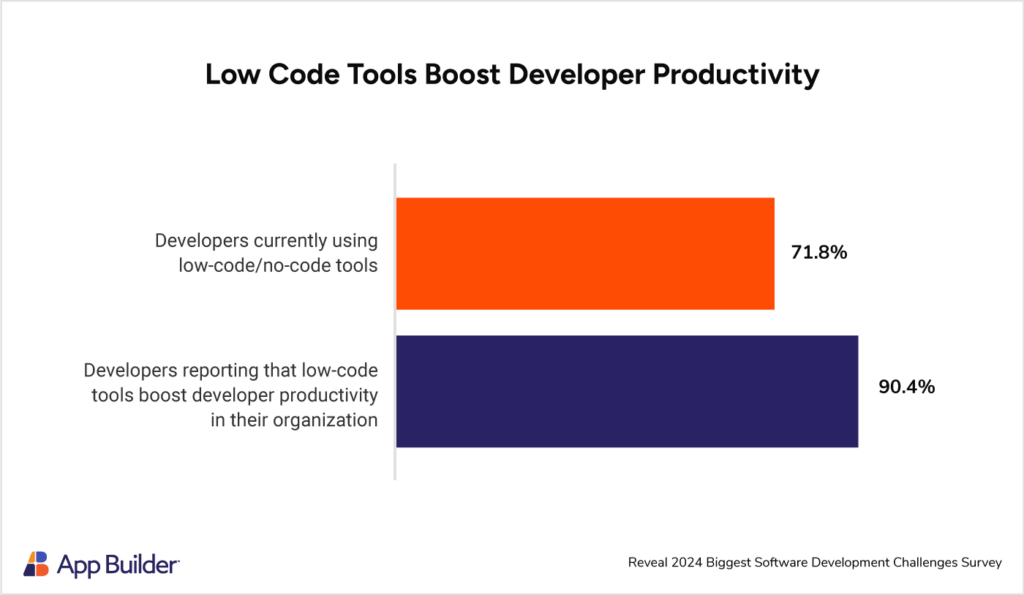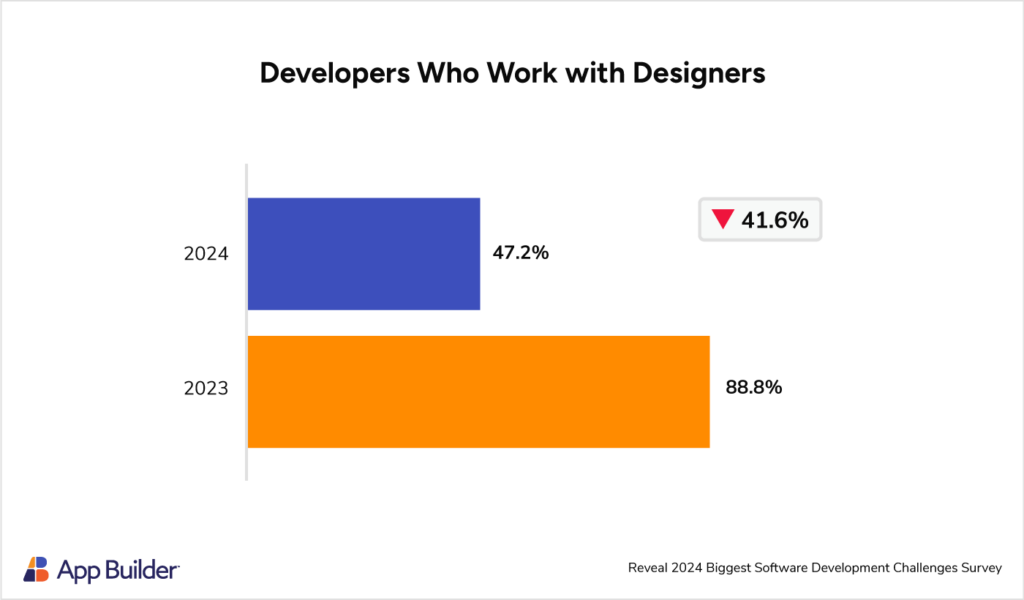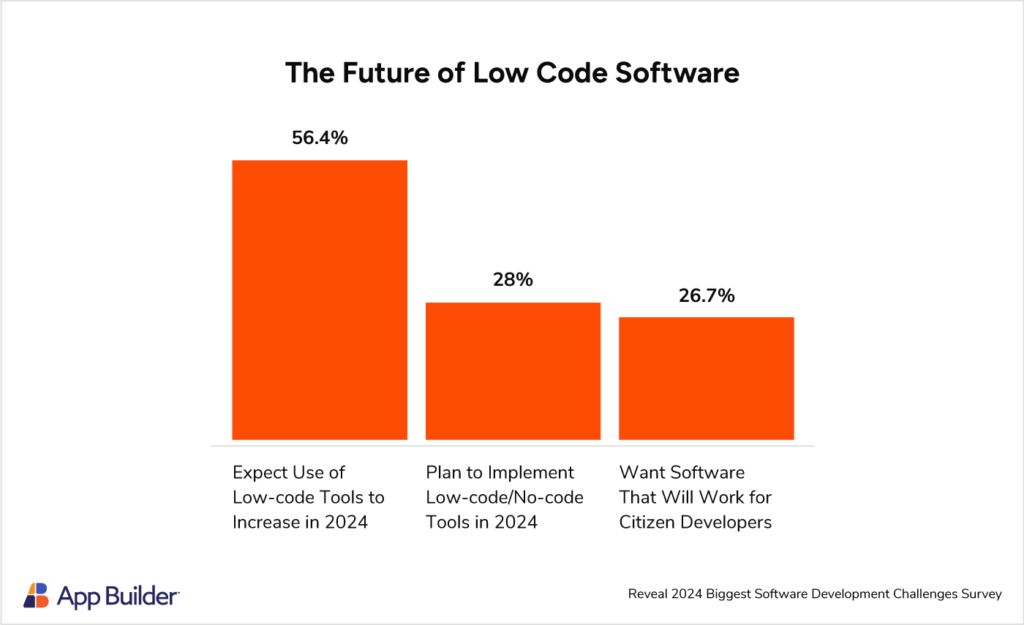2024 Reveal Survey Report: Low-Code Tools Boost Productivity

Biggest Software Development Challenges in 2024
According to the 2024 Top Software Development Challenges survey by Reveal, some of the biggest pain points that software developers, CIOs, enterprises, and teams face are limited resources, high workloads, development backlogs, and a shortage of skilled developers. One solution to these challenges is low-code platforms, which fuel innovation, use fewer resources, and provide a major productivity boost.
This survey report covers:
- Low-code’s Role in Boosting Productivity
- Bridging the Designer-Developer Gap
- The Market for Low-Code Tools
- Factors Influencing the Low-Code Boom
- Conclusion
Continue reading
Fill out the form to continue reading
Introduction
Low-code tools have emerged as the cornerstone of modern-day app development, driving innovation, digital transformation, and helping companies overcome the challenges they face in their business and processes.
According to the annual 2024 Top Software Development Challenges Survey by Reveal, an innovative product for embedded analytics by Infragistics, some of the biggest pain points that software developers, CIOs, enterprises, and teams must tackle are:
- High workload/not enough time to get the work done.
- Limited resources (lack of budget, unable to maintain software).
- Recruiting and retaining developers with the right skills.
The survey examines the major challenges mentioned above and provides valuable insights that can help companies build informed decisions and better strategies through new tools, technologies, and approaches.
Low-Code Tools’ Role in Boosting Productivity
One of the biggest software developments in recent history – low-code software – has emerged as a powerful tool for boosting productivity, the new Reveal survey of software developers found. Nearly all of the 585 respondents (90.4%) said that low-code tools boosted developer productivity in their organizations.

Low-code platforms also provide cross-platform accessibility. Working as a single source of truth, low-code development tools save crucial time in operations like ideation, communication, collaboration, management, delivering POCs, prototyping, designing, generating production-ready code, developing, deploying, testing, and more.
In an age of developer shortages and overworked programmers, low-code software not only increases productivity, but it also improves organizational efficiency, overcomes development backlogs, reduces costs, and uses fewer resources.
Bridging the Designer-Developer Gap
Low-code tools make it easier to create apps without a designer by using visual programming approaches and graphical user interfaces. One of the most significant benefits of adding no-code tools to your capabilities is that they bridge the gap between design and development. Nearly half of respondents (47.2%) work with a designer in 2024 compared to 88.8% who worked with a designer in 2023, the survey found.

“Low-code software has real value in democratizing software development to include non-developers,”
“Low-code software has real value in democratizing software development to include non-developers,” says Jason Beres, Senior VP of Developer Tools at Infragistics and creator of App Builder software. “It puts users in control of application development and empowers teams to develop and modify applications using intuitive tools without coding expertise. The global shortage of skilled software developers has driven the implementation of low-code software for non-programmers and has resulted in improved efficiency.”
The Market for Low-Code Tools is Exploding
The use of low-code platforms like App Builder, which makes it easy for non-technical staff to create modern business apps, have soared in recent years, with two-thirds (71.8%) of software developers currently using low-code/no-code tools, according to the 2024 Reveal Top Software Development Challenges survey.
More than half (56.4%) of respondents expect their use of low-code tools to increase in 2024. Nearly one in three developers (28%) plan to implement low-code/no-code tools in 2024 and 26.7% want software that will work for citizen developers.

App building is a major drain on development time with 28.2% of a software developer’s time spent coding the app and 24.8% of time designing the app. This is an improvement over 2023 when software developers spent 43.4% of their time coding apps. A majority (43.5%) of developers are saving up to 50% of their time when they use low-code tools on a project. In addition, a third (33.5%) of respondents plan to implement designer/developer collaboration tools.
According to KPMG, “Analysts predict that low code will become the preferred software development method by 2025. Gartner expects the market to grow to almost $30 billion by then, with a compound annual growth rate of 20 percent. Clearly, the industry has great expectations for low-code adoption and utilization. For now, companies are deciding how to transition from selective low-code adoption to the cohesive, enterprise-wide approach that would drive these lofty growth expectations.”
Factors That Are Influencing the Low-Code Boom
“Strained technology budgets, a shortage of developers, and the pressure to work efficiently and deliver better services have fueled the low-code boom,” says Beres. “Companies are realizing that if they streamline their low-code stack, they can achieve cost reductions, enhance business resilience, and better adapt to a rapidly changing competitive landscape.”
In addition, there is a growing need for rapid application development solutions as businesses across industries strive to modernize their operations and adapt to the digital era.
Other factors attributed to the low-code boom are agility and speed and the ability to accelerate app development lifecycles by enabling rapid prototyping, faster iterative development, and quicker deployment.
Low-code benefits include:
- It is a cost-effective alternative because low code can reduce the need for extensive coding.
- It provides flexibility so organizations can adapt quickly to evolving needs and customize apps to suit unique workflows and processes.
- It offers a simplified development process and enhanced interoperability.
- There is less time spent on designing, coding the app from scratch, handling mundane and repetitive tasks.
- It offers a single source of truth and eliminates the use of multiple tools.
Conclusion
Anyone with little coding experience can build apps today with low-code software, eliminating the need to write code line by line. These new tools provide a comprehensive library of UI controls, reusable drag-and-drop components, pre-built app templates, and additional options for customization and branding. Low-code software makes it easier to work on outsourced projects and with “citizen developers” while simultaneously addressing and tackling key business challenges like the shortage of skilled developers.
Serving as a single source of truth, low-code platforms also enable designers, developers, stakeholders, and project managers to collaborate and eliminate manual tasks or miscommunication when handling designer-developer handoffs. Everyone involved in the digital product design and development process can more easily perform user and usability testing, inspect prototypes, and see the end result instantly.
The rise of low-code/no-code platforms is shaking up the world of software development – not by replacing traditional programmers but by expanding the toolkits available to software developers and enhancing their productivity.
About the survey
585 software developers and IT professionals participated in Infragistics’ Reveal 2024 survey from December 2023 to January 2024.

